Foundation of Marketing: Analyzing Product Quality and Marketing Mix
VerifiedAdded on 2022/09/28
|6
|1646
|50
Report
AI Summary
This report, titled "Foundation of Marketing," delves into the core concepts of marketing, emphasizing the marketing mix elements: product, price, place, and promotion. The report argues that while product quality is crucial, other marketing elements such as distribution, pricing, and promotion can significantly influence consumer perception and brand success. It provides examples such as Coca-Cola's distribution strategy, Apple's pricing strategy, and Sony Aibo's promotional efforts to illustrate how these elements can sometimes overshadow product quality. The paper concludes that a balanced approach, considering all marketing mix elements, is essential for achieving successful brand launches and long-term sustainability in today's competitive market. It references various academic sources to support its arguments.
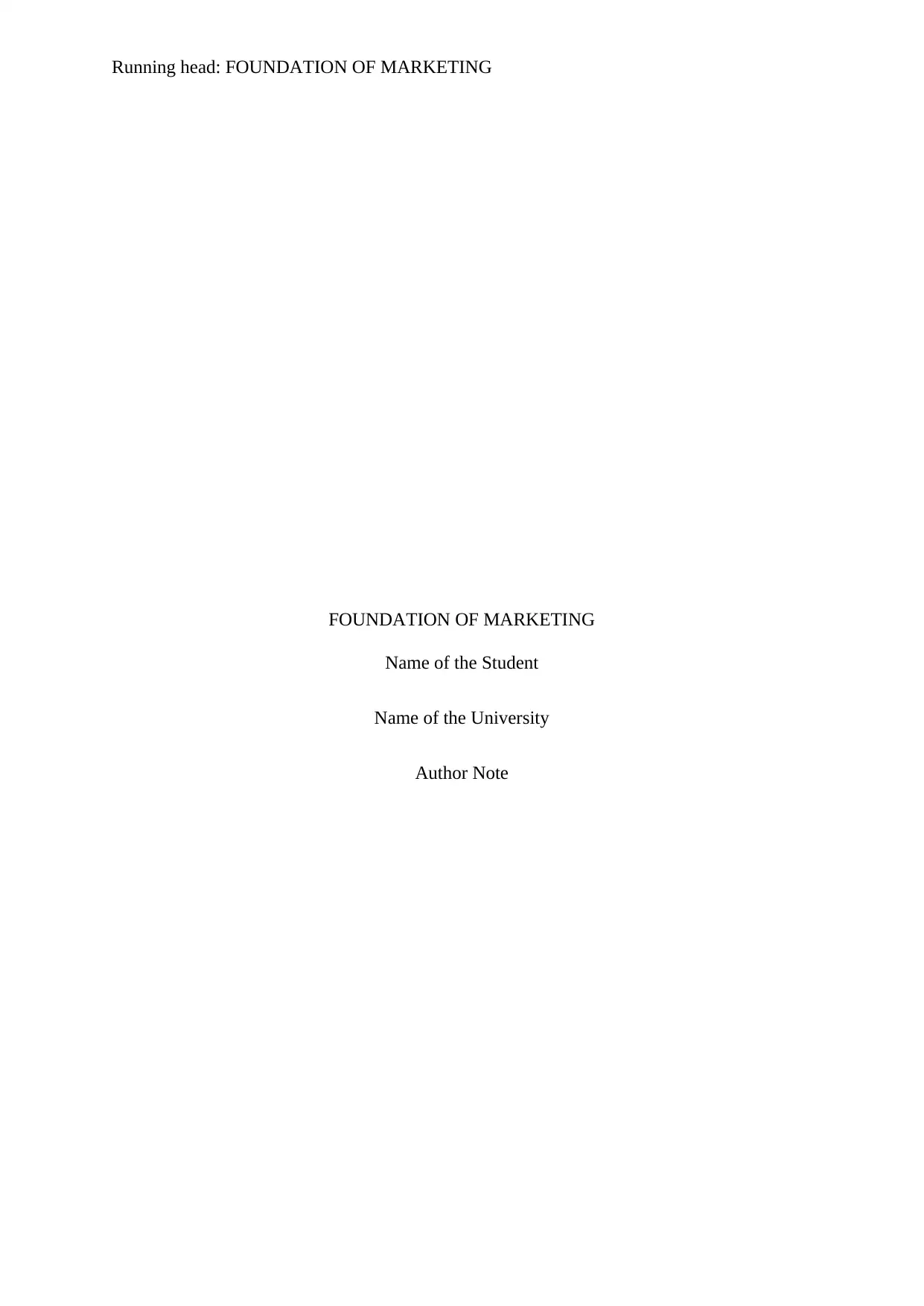
Running head: FOUNDATION OF MARKETING
FOUNDATION OF MARKETING
Name of the Student
Name of the University
Author Note
FOUNDATION OF MARKETING
Name of the Student
Name of the University
Author Note
Paraphrase This Document
Need a fresh take? Get an instant paraphrase of this document with our AI Paraphraser
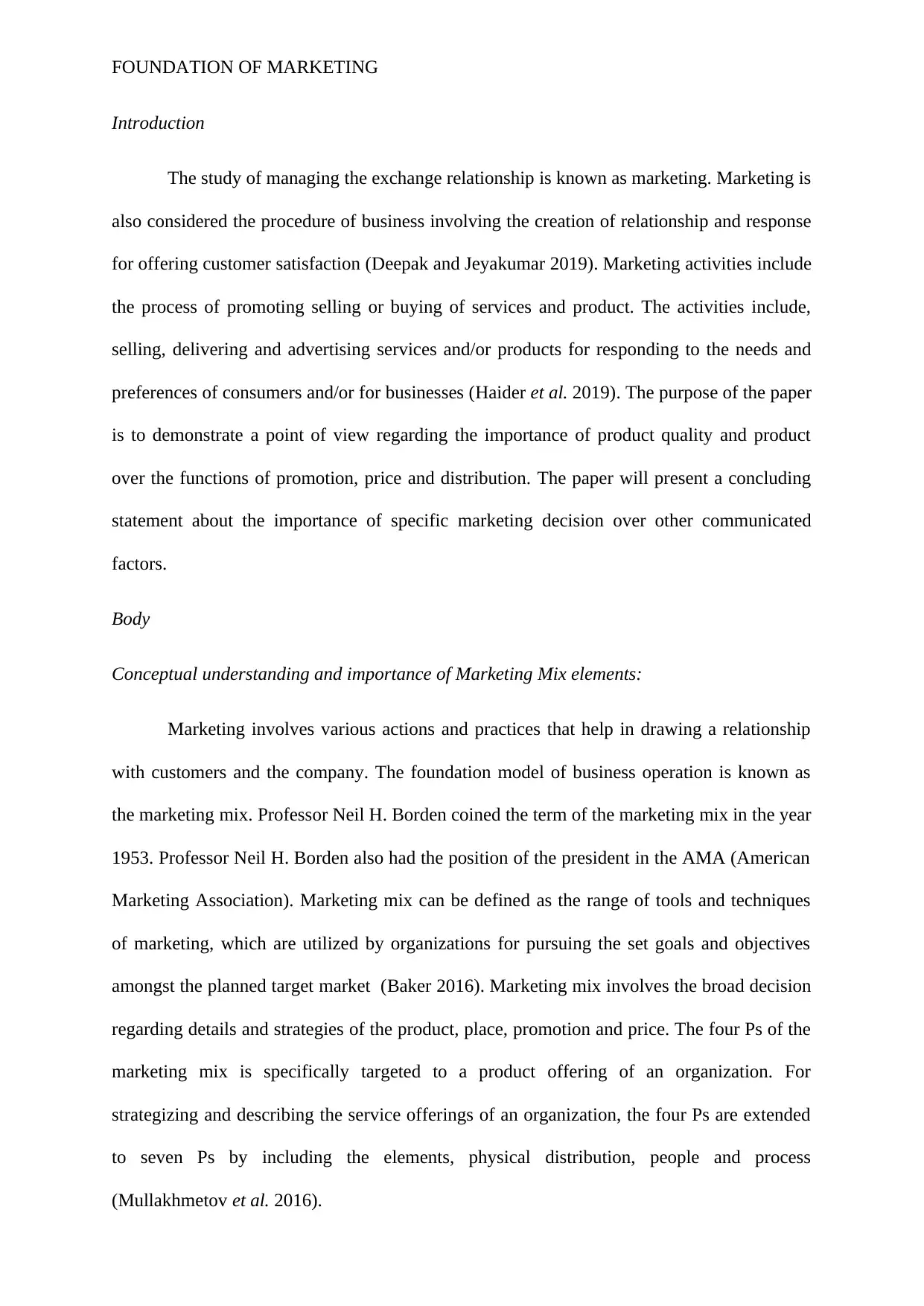
FOUNDATION OF MARKETING
Introduction
The study of managing the exchange relationship is known as marketing. Marketing is
also considered the procedure of business involving the creation of relationship and response
for offering customer satisfaction (Deepak and Jeyakumar 2019). Marketing activities include
the process of promoting selling or buying of services and product. The activities include,
selling, delivering and advertising services and/or products for responding to the needs and
preferences of consumers and/or for businesses (Haider et al. 2019). The purpose of the paper
is to demonstrate a point of view regarding the importance of product quality and product
over the functions of promotion, price and distribution. The paper will present a concluding
statement about the importance of specific marketing decision over other communicated
factors.
Body
Conceptual understanding and importance of Marketing Mix elements:
Marketing involves various actions and practices that help in drawing a relationship
with customers and the company. The foundation model of business operation is known as
the marketing mix. Professor Neil H. Borden coined the term of the marketing mix in the year
1953. Professor Neil H. Borden also had the position of the president in the AMA (American
Marketing Association). Marketing mix can be defined as the range of tools and techniques
of marketing, which are utilized by organizations for pursuing the set goals and objectives
amongst the planned target market (Baker 2016). Marketing mix involves the broad decision
regarding details and strategies of the product, place, promotion and price. The four Ps of the
marketing mix is specifically targeted to a product offering of an organization. For
strategizing and describing the service offerings of an organization, the four Ps are extended
to seven Ps by including the elements, physical distribution, people and process
(Mullakhmetov et al. 2016).
Introduction
The study of managing the exchange relationship is known as marketing. Marketing is
also considered the procedure of business involving the creation of relationship and response
for offering customer satisfaction (Deepak and Jeyakumar 2019). Marketing activities include
the process of promoting selling or buying of services and product. The activities include,
selling, delivering and advertising services and/or products for responding to the needs and
preferences of consumers and/or for businesses (Haider et al. 2019). The purpose of the paper
is to demonstrate a point of view regarding the importance of product quality and product
over the functions of promotion, price and distribution. The paper will present a concluding
statement about the importance of specific marketing decision over other communicated
factors.
Body
Conceptual understanding and importance of Marketing Mix elements:
Marketing involves various actions and practices that help in drawing a relationship
with customers and the company. The foundation model of business operation is known as
the marketing mix. Professor Neil H. Borden coined the term of the marketing mix in the year
1953. Professor Neil H. Borden also had the position of the president in the AMA (American
Marketing Association). Marketing mix can be defined as the range of tools and techniques
of marketing, which are utilized by organizations for pursuing the set goals and objectives
amongst the planned target market (Baker 2016). Marketing mix involves the broad decision
regarding details and strategies of the product, place, promotion and price. The four Ps of the
marketing mix is specifically targeted to a product offering of an organization. For
strategizing and describing the service offerings of an organization, the four Ps are extended
to seven Ps by including the elements, physical distribution, people and process
(Mullakhmetov et al. 2016).
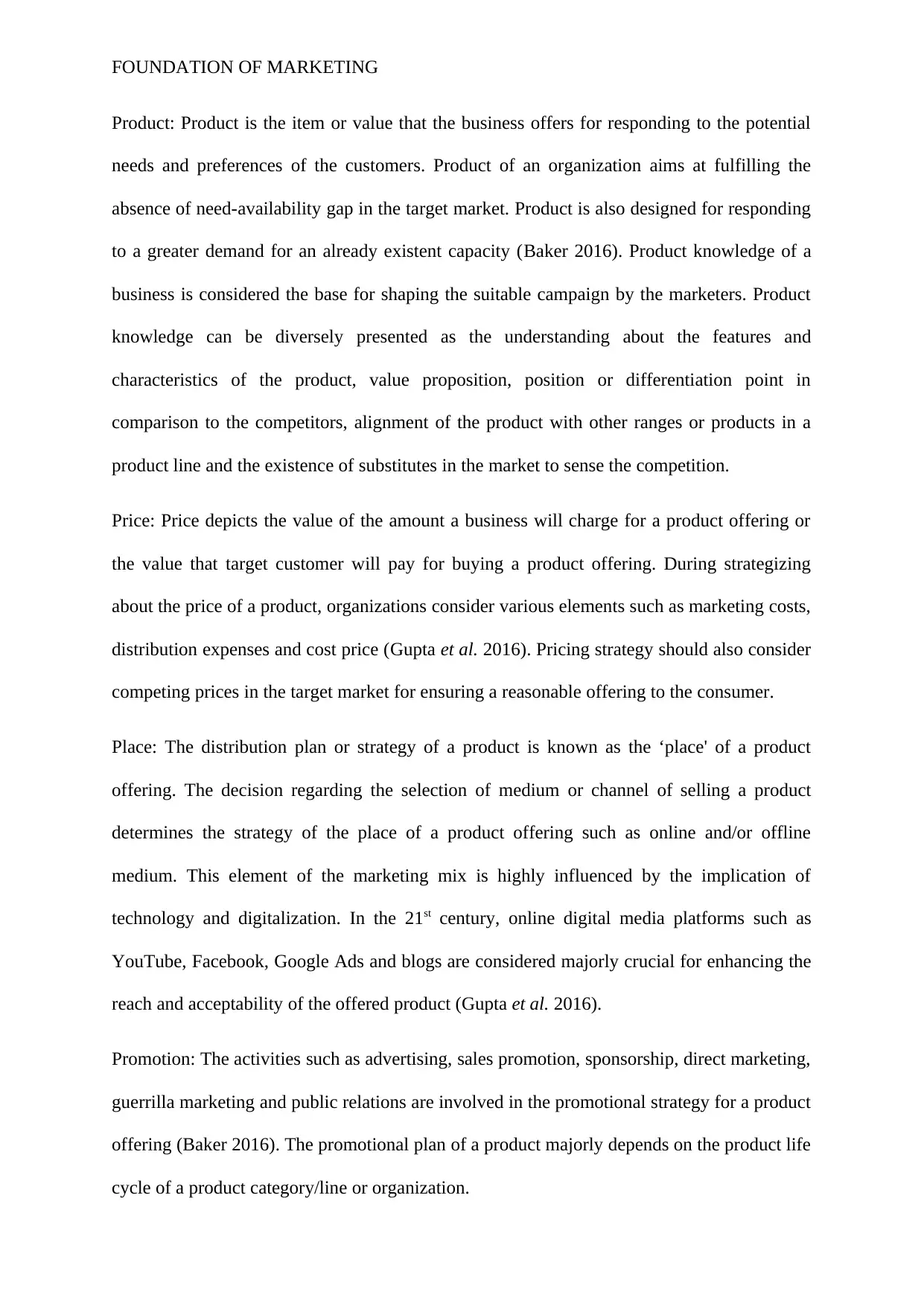
FOUNDATION OF MARKETING
Product: Product is the item or value that the business offers for responding to the potential
needs and preferences of the customers. Product of an organization aims at fulfilling the
absence of need-availability gap in the target market. Product is also designed for responding
to a greater demand for an already existent capacity (Baker 2016). Product knowledge of a
business is considered the base for shaping the suitable campaign by the marketers. Product
knowledge can be diversely presented as the understanding about the features and
characteristics of the product, value proposition, position or differentiation point in
comparison to the competitors, alignment of the product with other ranges or products in a
product line and the existence of substitutes in the market to sense the competition.
Price: Price depicts the value of the amount a business will charge for a product offering or
the value that target customer will pay for buying a product offering. During strategizing
about the price of a product, organizations consider various elements such as marketing costs,
distribution expenses and cost price (Gupta et al. 2016). Pricing strategy should also consider
competing prices in the target market for ensuring a reasonable offering to the consumer.
Place: The distribution plan or strategy of a product is known as the ‘place' of a product
offering. The decision regarding the selection of medium or channel of selling a product
determines the strategy of the place of a product offering such as online and/or offline
medium. This element of the marketing mix is highly influenced by the implication of
technology and digitalization. In the 21st century, online digital media platforms such as
YouTube, Facebook, Google Ads and blogs are considered majorly crucial for enhancing the
reach and acceptability of the offered product (Gupta et al. 2016).
Promotion: The activities such as advertising, sales promotion, sponsorship, direct marketing,
guerrilla marketing and public relations are involved in the promotional strategy for a product
offering (Baker 2016). The promotional plan of a product majorly depends on the product life
cycle of a product category/line or organization.
Product: Product is the item or value that the business offers for responding to the potential
needs and preferences of the customers. Product of an organization aims at fulfilling the
absence of need-availability gap in the target market. Product is also designed for responding
to a greater demand for an already existent capacity (Baker 2016). Product knowledge of a
business is considered the base for shaping the suitable campaign by the marketers. Product
knowledge can be diversely presented as the understanding about the features and
characteristics of the product, value proposition, position or differentiation point in
comparison to the competitors, alignment of the product with other ranges or products in a
product line and the existence of substitutes in the market to sense the competition.
Price: Price depicts the value of the amount a business will charge for a product offering or
the value that target customer will pay for buying a product offering. During strategizing
about the price of a product, organizations consider various elements such as marketing costs,
distribution expenses and cost price (Gupta et al. 2016). Pricing strategy should also consider
competing prices in the target market for ensuring a reasonable offering to the consumer.
Place: The distribution plan or strategy of a product is known as the ‘place' of a product
offering. The decision regarding the selection of medium or channel of selling a product
determines the strategy of the place of a product offering such as online and/or offline
medium. This element of the marketing mix is highly influenced by the implication of
technology and digitalization. In the 21st century, online digital media platforms such as
YouTube, Facebook, Google Ads and blogs are considered majorly crucial for enhancing the
reach and acceptability of the offered product (Gupta et al. 2016).
Promotion: The activities such as advertising, sales promotion, sponsorship, direct marketing,
guerrilla marketing and public relations are involved in the promotional strategy for a product
offering (Baker 2016). The promotional plan of a product majorly depends on the product life
cycle of a product category/line or organization.
⊘ This is a preview!⊘
Do you want full access?
Subscribe today to unlock all pages.

Trusted by 1+ million students worldwide
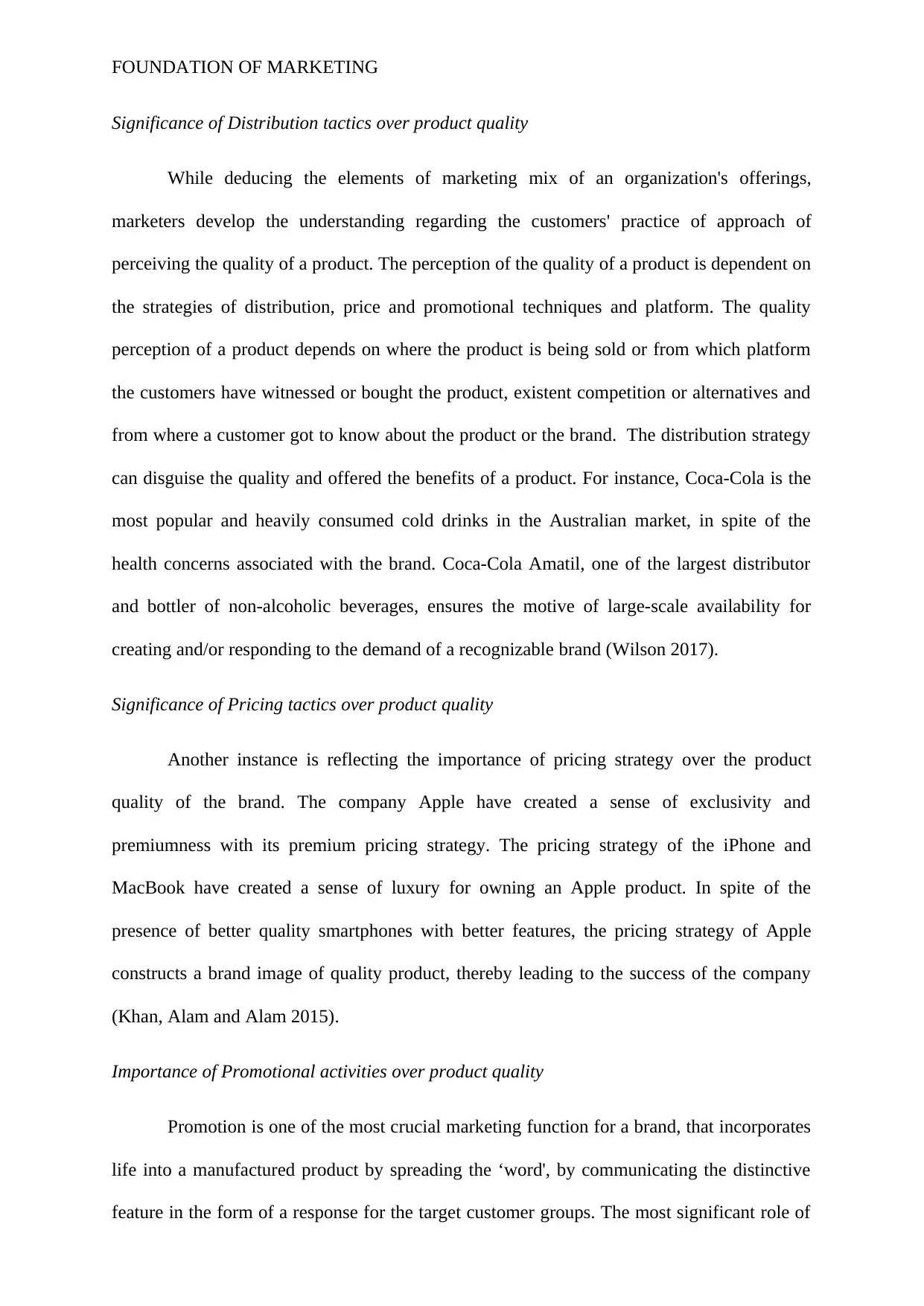
FOUNDATION OF MARKETING
Significance of Distribution tactics over product quality
While deducing the elements of marketing mix of an organization's offerings,
marketers develop the understanding regarding the customers' practice of approach of
perceiving the quality of a product. The perception of the quality of a product is dependent on
the strategies of distribution, price and promotional techniques and platform. The quality
perception of a product depends on where the product is being sold or from which platform
the customers have witnessed or bought the product, existent competition or alternatives and
from where a customer got to know about the product or the brand. The distribution strategy
can disguise the quality and offered the benefits of a product. For instance, Coca-Cola is the
most popular and heavily consumed cold drinks in the Australian market, in spite of the
health concerns associated with the brand. Coca-Cola Amatil, one of the largest distributor
and bottler of non-alcoholic beverages, ensures the motive of large-scale availability for
creating and/or responding to the demand of a recognizable brand (Wilson 2017).
Significance of Pricing tactics over product quality
Another instance is reflecting the importance of pricing strategy over the product
quality of the brand. The company Apple have created a sense of exclusivity and
premiumness with its premium pricing strategy. The pricing strategy of the iPhone and
MacBook have created a sense of luxury for owning an Apple product. In spite of the
presence of better quality smartphones with better features, the pricing strategy of Apple
constructs a brand image of quality product, thereby leading to the success of the company
(Khan, Alam and Alam 2015).
Importance of Promotional activities over product quality
Promotion is one of the most crucial marketing function for a brand, that incorporates
life into a manufactured product by spreading the ‘word', by communicating the distinctive
feature in the form of a response for the target customer groups. The most significant role of
Significance of Distribution tactics over product quality
While deducing the elements of marketing mix of an organization's offerings,
marketers develop the understanding regarding the customers' practice of approach of
perceiving the quality of a product. The perception of the quality of a product is dependent on
the strategies of distribution, price and promotional techniques and platform. The quality
perception of a product depends on where the product is being sold or from which platform
the customers have witnessed or bought the product, existent competition or alternatives and
from where a customer got to know about the product or the brand. The distribution strategy
can disguise the quality and offered the benefits of a product. For instance, Coca-Cola is the
most popular and heavily consumed cold drinks in the Australian market, in spite of the
health concerns associated with the brand. Coca-Cola Amatil, one of the largest distributor
and bottler of non-alcoholic beverages, ensures the motive of large-scale availability for
creating and/or responding to the demand of a recognizable brand (Wilson 2017).
Significance of Pricing tactics over product quality
Another instance is reflecting the importance of pricing strategy over the product
quality of the brand. The company Apple have created a sense of exclusivity and
premiumness with its premium pricing strategy. The pricing strategy of the iPhone and
MacBook have created a sense of luxury for owning an Apple product. In spite of the
presence of better quality smartphones with better features, the pricing strategy of Apple
constructs a brand image of quality product, thereby leading to the success of the company
(Khan, Alam and Alam 2015).
Importance of Promotional activities over product quality
Promotion is one of the most crucial marketing function for a brand, that incorporates
life into a manufactured product by spreading the ‘word', by communicating the distinctive
feature in the form of a response for the target customer groups. The most significant role of
Paraphrase This Document
Need a fresh take? Get an instant paraphrase of this document with our AI Paraphraser
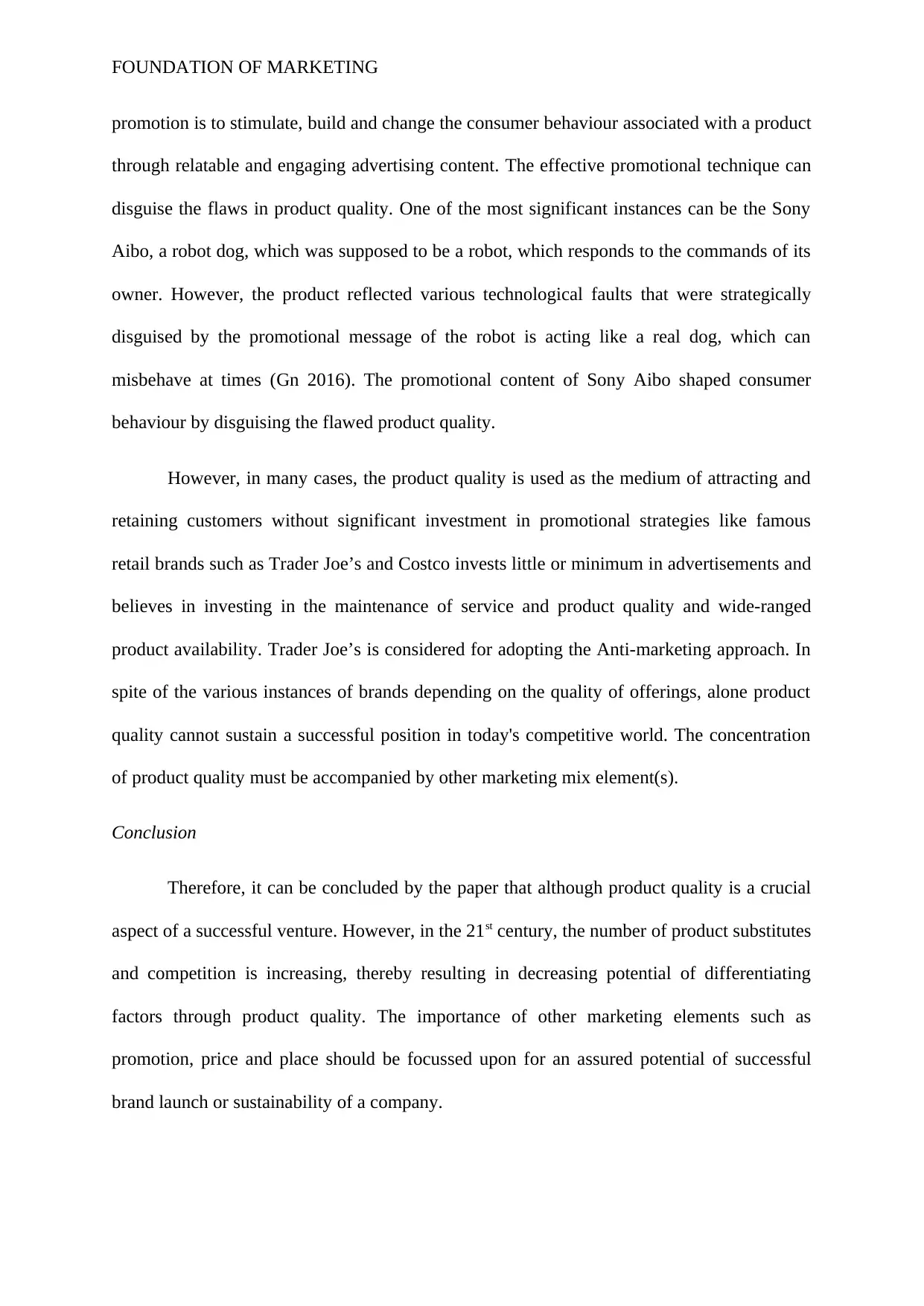
FOUNDATION OF MARKETING
promotion is to stimulate, build and change the consumer behaviour associated with a product
through relatable and engaging advertising content. The effective promotional technique can
disguise the flaws in product quality. One of the most significant instances can be the Sony
Aibo, a robot dog, which was supposed to be a robot, which responds to the commands of its
owner. However, the product reflected various technological faults that were strategically
disguised by the promotional message of the robot is acting like a real dog, which can
misbehave at times (Gn 2016). The promotional content of Sony Aibo shaped consumer
behaviour by disguising the flawed product quality.
However, in many cases, the product quality is used as the medium of attracting and
retaining customers without significant investment in promotional strategies like famous
retail brands such as Trader Joe’s and Costco invests little or minimum in advertisements and
believes in investing in the maintenance of service and product quality and wide-ranged
product availability. Trader Joe’s is considered for adopting the Anti-marketing approach. In
spite of the various instances of brands depending on the quality of offerings, alone product
quality cannot sustain a successful position in today's competitive world. The concentration
of product quality must be accompanied by other marketing mix element(s).
Conclusion
Therefore, it can be concluded by the paper that although product quality is a crucial
aspect of a successful venture. However, in the 21st century, the number of product substitutes
and competition is increasing, thereby resulting in decreasing potential of differentiating
factors through product quality. The importance of other marketing elements such as
promotion, price and place should be focussed upon for an assured potential of successful
brand launch or sustainability of a company.
promotion is to stimulate, build and change the consumer behaviour associated with a product
through relatable and engaging advertising content. The effective promotional technique can
disguise the flaws in product quality. One of the most significant instances can be the Sony
Aibo, a robot dog, which was supposed to be a robot, which responds to the commands of its
owner. However, the product reflected various technological faults that were strategically
disguised by the promotional message of the robot is acting like a real dog, which can
misbehave at times (Gn 2016). The promotional content of Sony Aibo shaped consumer
behaviour by disguising the flawed product quality.
However, in many cases, the product quality is used as the medium of attracting and
retaining customers without significant investment in promotional strategies like famous
retail brands such as Trader Joe’s and Costco invests little or minimum in advertisements and
believes in investing in the maintenance of service and product quality and wide-ranged
product availability. Trader Joe’s is considered for adopting the Anti-marketing approach. In
spite of the various instances of brands depending on the quality of offerings, alone product
quality cannot sustain a successful position in today's competitive world. The concentration
of product quality must be accompanied by other marketing mix element(s).
Conclusion
Therefore, it can be concluded by the paper that although product quality is a crucial
aspect of a successful venture. However, in the 21st century, the number of product substitutes
and competition is increasing, thereby resulting in decreasing potential of differentiating
factors through product quality. The importance of other marketing elements such as
promotion, price and place should be focussed upon for an assured potential of successful
brand launch or sustainability of a company.
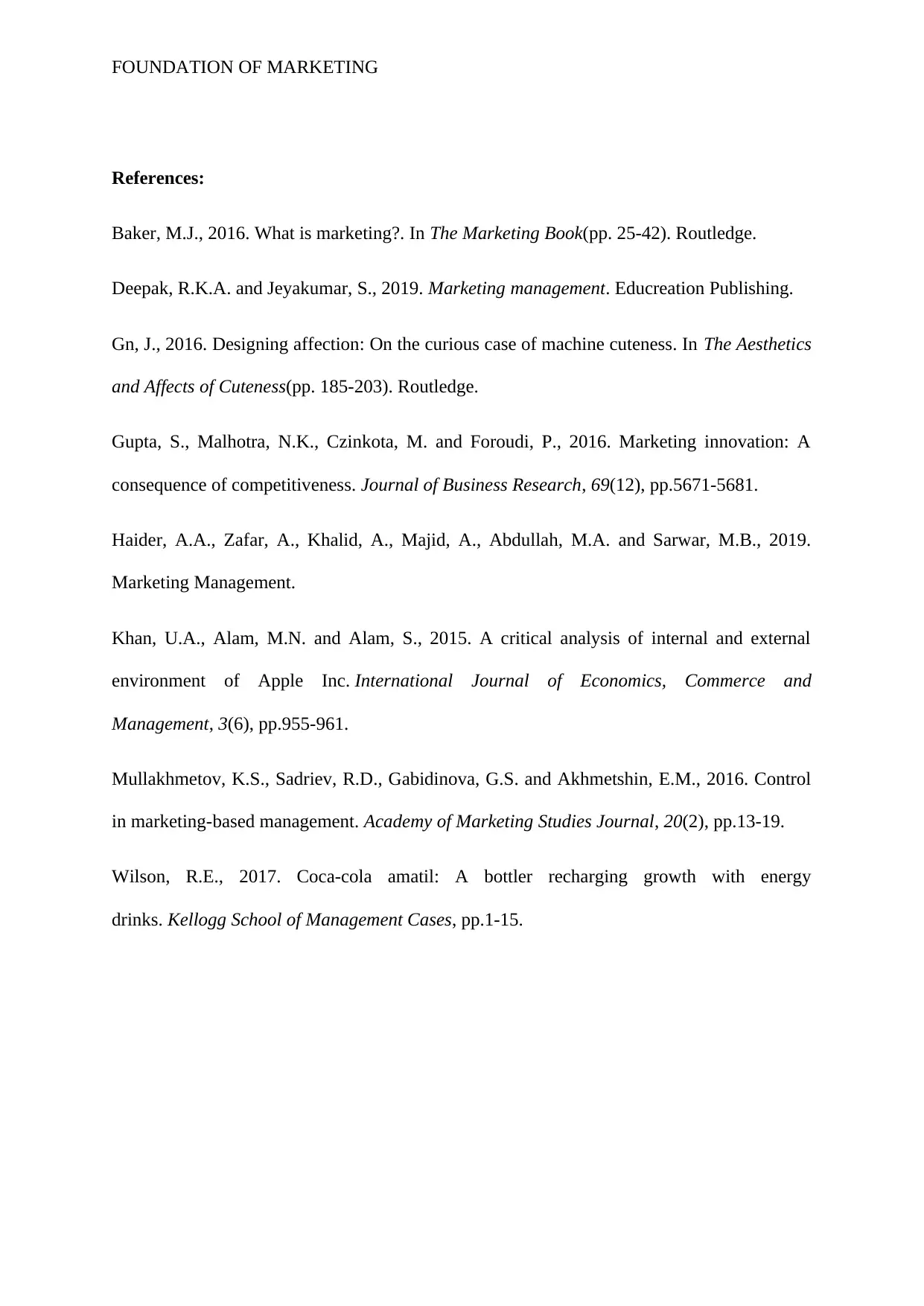
FOUNDATION OF MARKETING
References:
Baker, M.J., 2016. What is marketing?. In The Marketing Book(pp. 25-42). Routledge.
Deepak, R.K.A. and Jeyakumar, S., 2019. Marketing management. Educreation Publishing.
Gn, J., 2016. Designing affection: On the curious case of machine cuteness. In The Aesthetics
and Affects of Cuteness(pp. 185-203). Routledge.
Gupta, S., Malhotra, N.K., Czinkota, M. and Foroudi, P., 2016. Marketing innovation: A
consequence of competitiveness. Journal of Business Research, 69(12), pp.5671-5681.
Haider, A.A., Zafar, A., Khalid, A., Majid, A., Abdullah, M.A. and Sarwar, M.B., 2019.
Marketing Management.
Khan, U.A., Alam, M.N. and Alam, S., 2015. A critical analysis of internal and external
environment of Apple Inc. International Journal of Economics, Commerce and
Management, 3(6), pp.955-961.
Mullakhmetov, K.S., Sadriev, R.D., Gabidinova, G.S. and Akhmetshin, E.M., 2016. Control
in marketing-based management. Academy of Marketing Studies Journal, 20(2), pp.13-19.
Wilson, R.E., 2017. Coca-cola amatil: A bottler recharging growth with energy
drinks. Kellogg School of Management Cases, pp.1-15.
References:
Baker, M.J., 2016. What is marketing?. In The Marketing Book(pp. 25-42). Routledge.
Deepak, R.K.A. and Jeyakumar, S., 2019. Marketing management. Educreation Publishing.
Gn, J., 2016. Designing affection: On the curious case of machine cuteness. In The Aesthetics
and Affects of Cuteness(pp. 185-203). Routledge.
Gupta, S., Malhotra, N.K., Czinkota, M. and Foroudi, P., 2016. Marketing innovation: A
consequence of competitiveness. Journal of Business Research, 69(12), pp.5671-5681.
Haider, A.A., Zafar, A., Khalid, A., Majid, A., Abdullah, M.A. and Sarwar, M.B., 2019.
Marketing Management.
Khan, U.A., Alam, M.N. and Alam, S., 2015. A critical analysis of internal and external
environment of Apple Inc. International Journal of Economics, Commerce and
Management, 3(6), pp.955-961.
Mullakhmetov, K.S., Sadriev, R.D., Gabidinova, G.S. and Akhmetshin, E.M., 2016. Control
in marketing-based management. Academy of Marketing Studies Journal, 20(2), pp.13-19.
Wilson, R.E., 2017. Coca-cola amatil: A bottler recharging growth with energy
drinks. Kellogg School of Management Cases, pp.1-15.
⊘ This is a preview!⊘
Do you want full access?
Subscribe today to unlock all pages.

Trusted by 1+ million students worldwide
1 out of 6
Related Documents
Your All-in-One AI-Powered Toolkit for Academic Success.
+13062052269
info@desklib.com
Available 24*7 on WhatsApp / Email
![[object Object]](/_next/static/media/star-bottom.7253800d.svg)
Unlock your academic potential
Copyright © 2020–2025 A2Z Services. All Rights Reserved. Developed and managed by ZUCOL.




